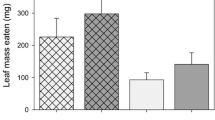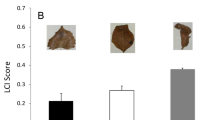Abstract
In plant-insect herbivore field studies, effects of cages, plant age, and mechanical clipping on host plant chemistry are often postulated but not well documented. We examined the effects of cages (for the purpose of restraining insects on experimental plots), plant age over the course of the experiment and mechanical clipping on plantain (Plantago lanceolata) chemistry. Leaf age affected the concentrations of nitrogen and iridoid glycosides (IGs; specifically aucubin and catalpol), with higher levels in newer leaves. Caged plants had higher levels of IGs and lower concentrations of nitrogen than uncaged plants. The IG concentrations were greater in new leaves of caged plants than uncaged plants, whereas the concentrations in mature leaves were unaffected by caging. Plants that were 5 weeks older had higher levels of IGs and lower nitrogen than plants harvested 5 weeks earlier. Comparison of three studies suggested that over the summer IG concentrations increase during dry years but decrease during wet years. Plants with above-ground parts clipped and then allowed to regrow for five weeks had similar concentrations of IGs and nitrogen compared to control plants; but the regrowth plants had a lower catalpol to total IG ratio. We conclude that cages and time can have significant positive effects on iridoid glycoside concentrations and significant negative effects on leaf nitrogen concentration. But our results also indicate that the direction and magnitude of the effects of cages, time and mechanical damage are not easily predicted. Therefore, it is advisable to determine and/or control for such effects in field experiments on plant-insect interactions.
Similar content being viewed by others
References
Baldwin IT (1988) The alkaloidal responses of wild tobacco to real and simulated herbivory. Oecologia 77:378–381
Baldwin IT (1989) Mechanism of damage-induced alkaloid production in wild tobacco. J Chem Ecol 15:1661–1680
Baldwin IT (1990) Herbivory simulations in ecological research. Trends Ecol Evol 5:91–93
Bobbitt JM, Segebarth KP (1969) Iridoid glycosides and similar substances. In: Taylor WI, Battersby AR (eds) Cyclopentanoid terpene derivatives. Dekker, New York, pp 1–145
Bowers MD (1980) Unpalatability as a defense strategy of Euphydryas phaeton (Lepidoptera: Nymphalidae). Evolution 34:586–600
Bowers MD (1991) Iridoid glycosides. In: Rosenthal G, Berenbaum M (eds) Herbivores: Their interaction with plant secondary metabolites. vol 1, 2nd edn. Academic Press, Orlando, pp 297–325
Bowers MD (1992) Evolution of unpalatability and the cost of chemical defense in insects. In: Roitberg BD, Isman MB (eds) Insect chemical ecology: an evolutionary approach. Chapman & Hall, New York, pp 216–244
Bowers MD, Collinge SK (1992) Fate of iridoid glycosides in different life stages of the buckeye, Junonia coenia (Lepidoptera: Nymphalidae). J Chem Ecol 18:817–831
Bowers MD, Farley S (1990) The behaviour of grey jays, Perisoreus canadensis, towards palatable and unpalatable Lepidoptera. Anim Behav 39:699–705
Bowers MD, Puttick GM (1988) Response of generalist and specialist insects to qualitative allelochemical variation. J Chem Ecol 14:319–334
Bowers MD, Puttick GM (1989) Iridoid glycosides and insect feeding preferences: gypsy moths (Lymantria dispar, Lymantridae) and buckeyes (Junonia coenia, Nymphalidae). Ecol Entomol 14:247–256
Bowers MD, Stamp NE (1992) Chemical variation within and between individuals of Plantago lanceolata (Plantaginaceae). J Chem Ecol 18:985–995
Bowers MD, Stamp NE (1993) Effects of plant age, genotype, and herbivory on Plantago performance and chemistry. Ecology 74:1778–1791
Bowers MD, Collinge SK, Gamble SE, Schmitt J (1992a) Effects of genotype, habitat, and seasonal variation on iridoid glycoside content of Plantago lanceolata (Plantaginaceae) and the implications for insect herbivores. Oecologia 91:201–207
Bowers MD, Stamp NE, Collinge SK (1992b) Early stage of host range expansion by a specialist herbivore, Euphydryas phaeton (Nymphalidae). Ecology 73:526–536
Briske DD, Camp BJ (1982) Water stress increases alkaloid concentration in threadleaf groundsel (Senecio longilobus). Weed Sci 30:106–114
Bryant JP, Chapin FS III, Klein DR (1983) Carbon/nutrient balance of boreal plants in relation to vertebrate herbivory. Oikos 40:357–368
Bryant JP, Chapin FS III, Reichardt PB, Clausen TP (1987) Response of winter chemical defense in Alaska paper birch and green alder to manipulation of plant carbon/nutrient balance. Oecologia 72:510–514
Carne PB (1965) Distribution of the eucalypt-defoliating sawfly Perga affinis affinis. Aust J Zool 13:593–612
Crawley MJ, Nachapong M (1984) Facultative defences and specialist herbivores? Cinnabar moth (Tyria jacobaeae) on the regrowth foliage of ragwort (Senecio jacobaea). Ecol Entomol 9:389–393
Damtoft S, Jensen SR, Nielsen BJ (1983) The biosynthesis of iridoid glycosides from 8-epi-deoxyloganic acid. Biochem Soc Trans 11:594–595
Detling JK, Dyer MI, Winn DT (1979) Net photosynthesis, root respiration, and regrowth of Bouteloua gracilis following simulated grazing. Oecologia 41:127–134
Duff RB, Bacon JSD, Mundie CM, Famer VC, Russell JD, Forrester AR (1965) Catalpol and methyl catalpol: naturally occurring glycosides in Plantago and Buddleia species. Biochem J 96:1–5
Fajer ED, Bowers MD, Bazzaz FA (1992) The effect of nutrients and enriched CO2 environments on production of carbonbased allelochemicals in Plantago: a test of the carbon/nutrient balance hypothesis. Am Nat 140:707–723
Gardner DR, Stermitz FR (1988) Host plant utilization and iridoid glycoside sequestration by Euphydryas anicia individuals and populations. J Chem Ecol 14:2147–2168
Gershenzon J (1984) Changes in the levels of plant secondary metabolites under water and nutrient stress. Rec Adv Phytochem 18:273–320
Hatcher PE (1990) Seasonal and age-related variation in the needle quality of five conifer species. Oecologia 85:200–212
Herms DA, Mattson WJ (1992) The dilemma of plants: to grow or defend. Q Rev Biol 67:283–335
Kearsley MJC, Whitham TG (1989) Developmental changes in resistance to herbivory: implications for individuals and populations. Ecology 70:422–434
Kooi RE, Van de Water TPM, Herrebout WM (1991) Food acceptance by a monophagous and an oligophagous insect in relation to seasonal changes in host plant suitability. Entomol Exp Appl 59:111–122
Larsson S, Wiren A, Ericsson T, Lundgren L (1986) Effects of light and nutrient stress on defensive chemistry and susceptibility to Galerucella lineola (Col., Chrysomelidae) in two Salix species. Oikos 47:205–210
Lindroth RL, Batzli GO, Seigler DS (1986) Patterns in the phytochemistry of three prairie plants. Biochem Syst Ecol 15:681–686
Lindroth RL, Hsia MT, Scriber JM (1987) Seasonal patterns in the phytochemistry of three Populus species. Biochem Syst Ecol 15:681–686
Mattson WJ, Haack RA (1987) The role of drought in outbreaks of plant-eating insects. Bioscience 37:110–118
McKey D (1979) The distribution of secondary compounds within plants. In: Rosenthal GA, Janzen DH (eds) Herbivores: Their interaction with secondary plant metabolites. Academic Press, New York, pp 55–133
McNaughton SJ, Wallace LL, Coughenour MB (1983) Plant adaptation in an ecosystem contest: effects of defoliation, nitrogen, and water on growth of an African C4 sedge. Ecology 64:307–318
National Climatic Data Center (1989) Climatological Data New York 1989 (vol 101). Asheville, NC
National Climatic Data Center (1991) Climatological Data New York 1991 (vol 103). Asheville, NC
Pullin AS (1986) Influence of the food plant, Urtica dioica, on larval development, feeding efficiencies, and voltinism of a specialist insect, Inachis io. Holarctic Ecol 9:72–78
Pullin AS (1987) Changes in leaf quality following clipping and regrowth of Urtica dioica, and consequences for a specialist insect herbivore, Aglais urticae. Oikos 49:39–45
Puttick GM, Bowers MD (1988) Effect of qualitative and quantitative variation in allelochemicals on a generalist insect: iridoid glycosides and the southern armyworm. J Chem Ecol 14:335–351
Raupp MJ, Denno RF (1983) Leaf age as a predictor of herbivore distribution and abundance. In: Denno RF, McClure MS (eds) Variable, plants and herbivores in natural and managed systems. Academic Press, New York, pp 91–124
Rockwood LL (1974) Seasonal changes in the susceptibility of Crescentia alata leaves to the flea beetle Oedionychus sp. Ecology 55:142–148
Schmitt J, Niles J, Wulff RD (1992) Norms of reaction of seed traits to maternal environments in Plantago lanceolata. Am Nat 139:451–466
Stamp NE, Bowers MD (1990) Phenology of nutritional differences between new and mature leaves and its effect on caterpillar growth. Ecol Entomol 15:447–454
Stamp NE, Bowers MD (1992) Behaviour of specialist and generalist caterpillars on plantain (Plantago lanceolata). Ecol. Entomol 17:273–279
Wagner MR, Clancy KM, Tinus RW (1990) Seasonal patterns in the allelochemicals of Pseudotsuga menziesii, Picea engelmanii and Abies concolor. Biochem Syst Ecol 18:215–220
Waterman PG, Mole S (1989) Extrinsic factors influencing production of secondary metabolites in plants. In: Bernays EA (ed) Insect-Plant Interactions, (vol 1). CRC Press, Boca Raton, Fla, pp 107–134
Waterman PG, Ross JAM, McKey DB (1984) Factors affecting levels of some phenolic compounds, digestibility, and nitrogen content of mature leaves of Barteria fistulosa (Passifloraceae). J Chem Ecol 10:387–401
Webb JW, Moran VC (1978) The influence of the host plant on the population dynamics of Acizzia russellae (Homoptera: Psyllidae). Ecol Entomol 3:313–321
Author information
Authors and Affiliations
Rights and permissions
About this article
Cite this article
Stamp, N.E., Deane Bowers, M. Effects of cages, plant age and mechanical clipping on plantain chemistry. Oecologia 99, 66–71 (1994). https://doi.org/10.1007/BF00317084
Received:
Accepted:
Issue Date:
DOI: https://doi.org/10.1007/BF00317084




